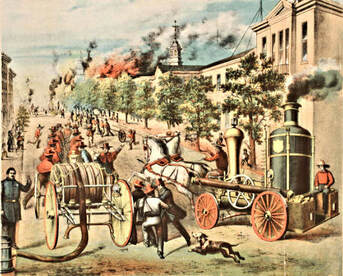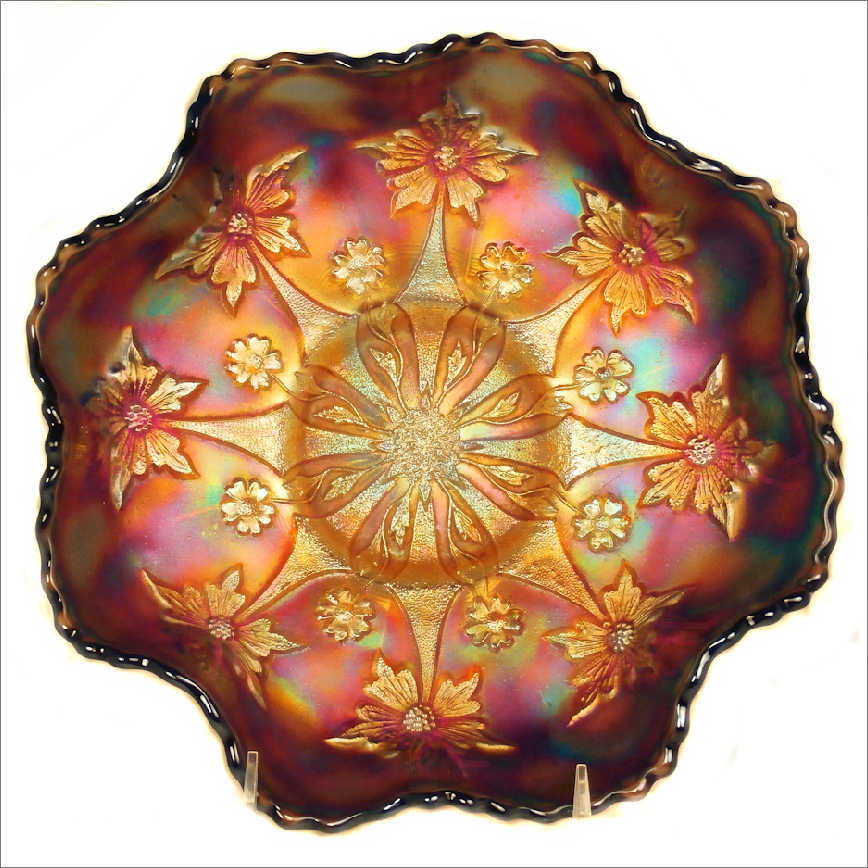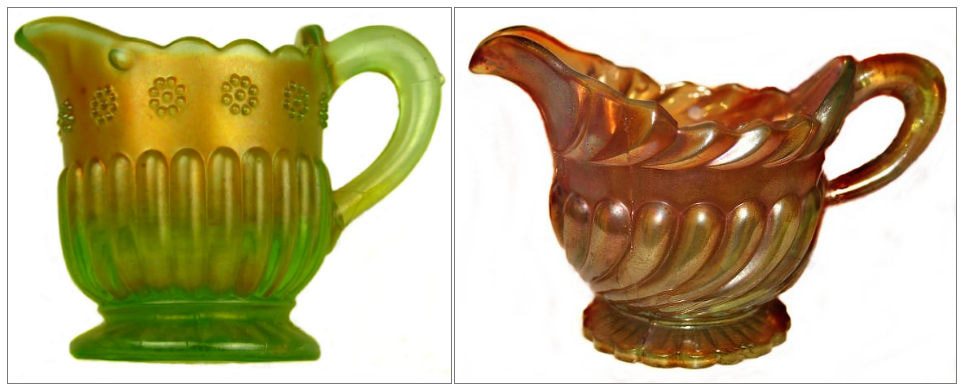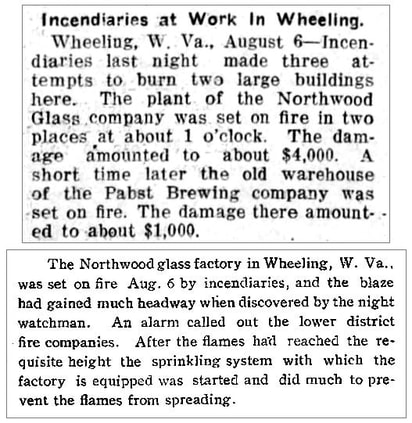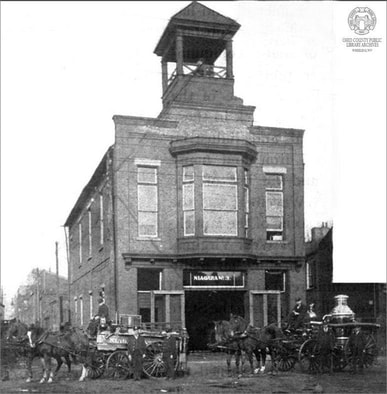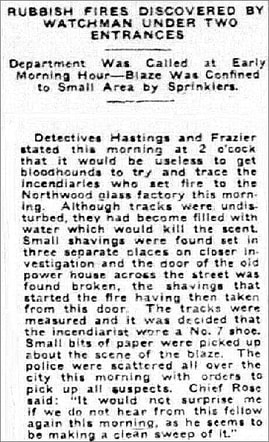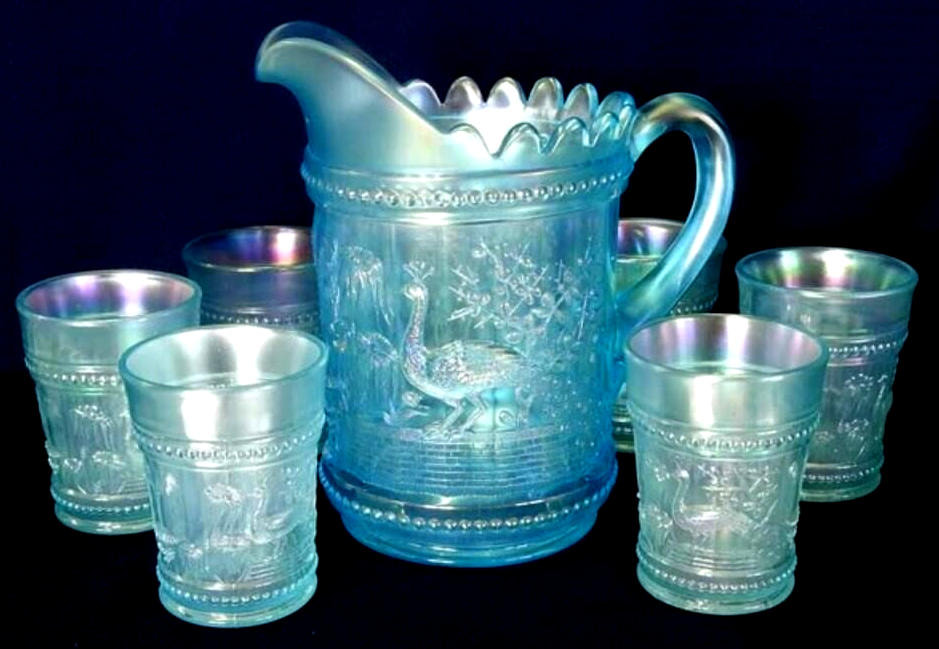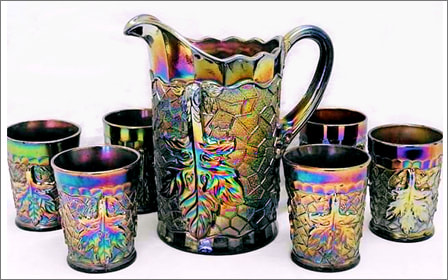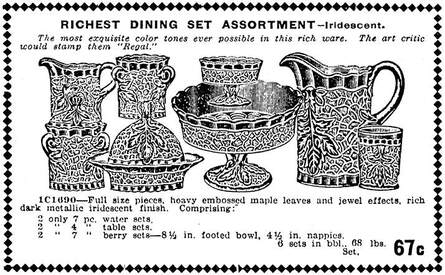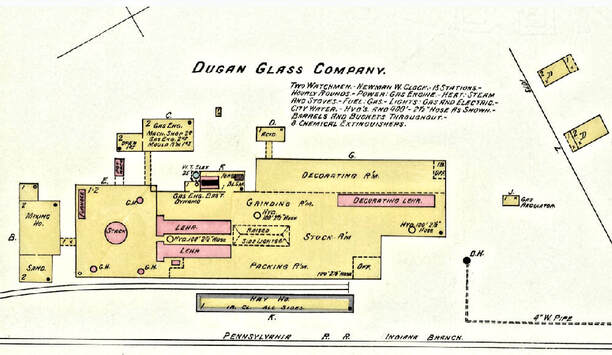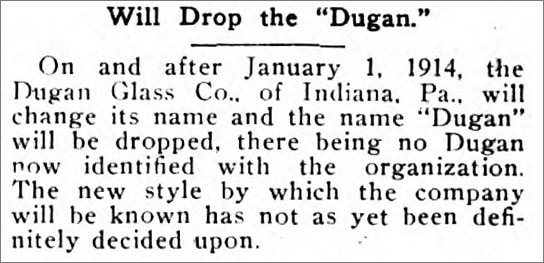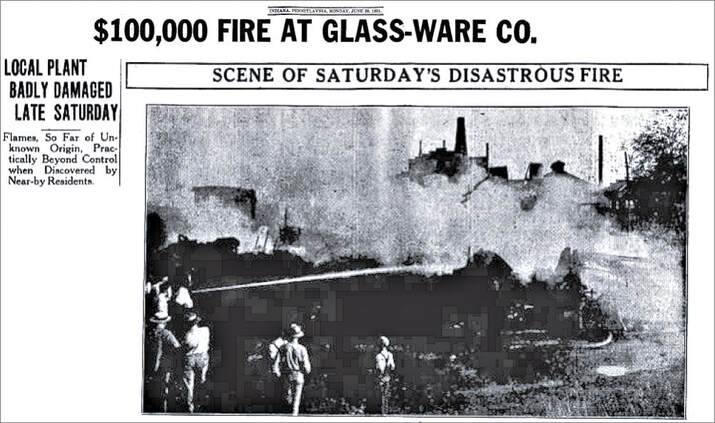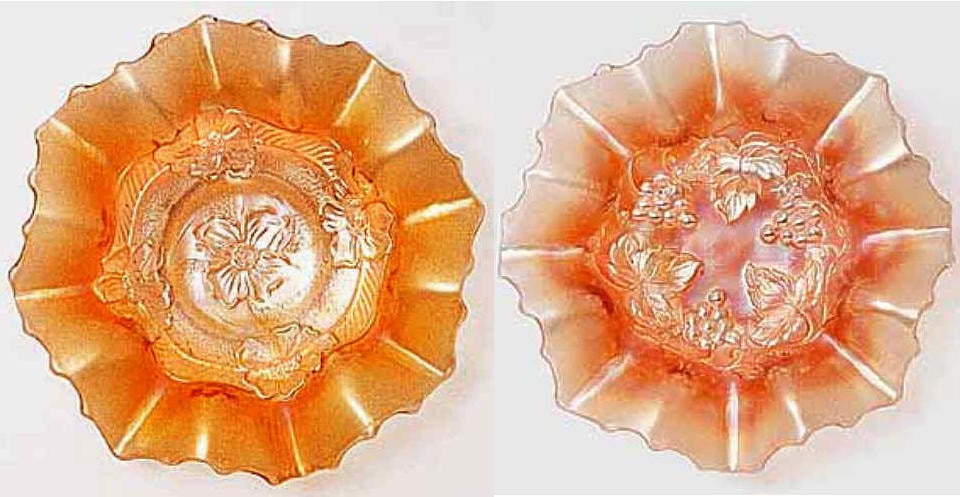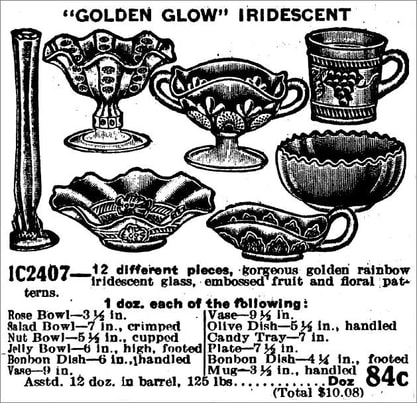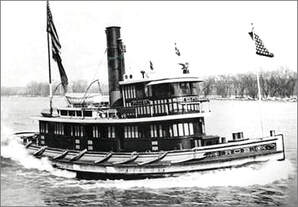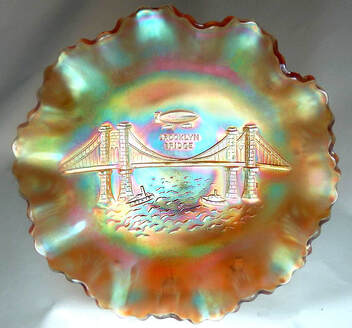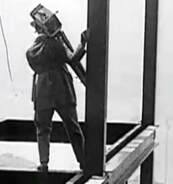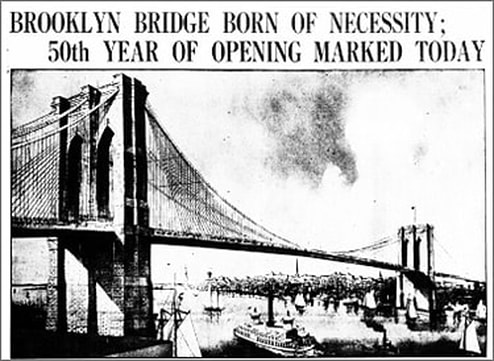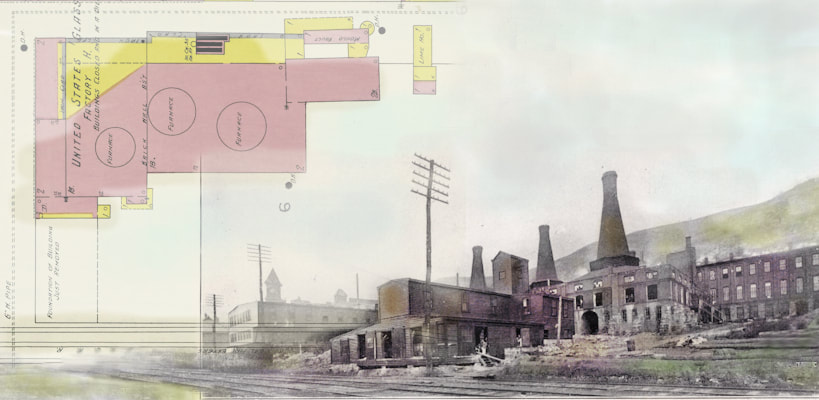NetworK ezine Issue 101. October 2023
Totally Devoted to Carnival Glass
Bringing the Past to Life
Glass – born of fire and sand. The Little Flowers bowl by Fenton (right) epitomizes its creation by fire. Not only was fire needed to make the glass batch, but more fire was required to bring the red / amberina colour to life. Our 101st. issue of NetworK looks at fire in the Carnival glass works – vital for production but an ever-present danger.
Fire!
Glass – born of fire and sand. The Little Flowers bowl by Fenton (right) epitomizes its creation by fire. Not only was fire needed to make the glass batch, but more fire was required to bring the red / amberina colour to life. Our 101st. issue of NetworK looks at fire in the Carnival glass works – vital for production but an ever-present danger.
Fire!
|
Back in the early days of Carnival production, fire was a constant concern for many glassworks. Working, as they did, with so many extreme heat sources – and lacking the “health and safety” initiatives of today’s industrial scene – the fear of accidental fire must have been the cause of many anxious moments. An 1866 Fire Insurance ad. Courtesy Historical Society of Philadelphia.
Hook and ladder trucks and hose carts would have been pulled by horses in the smaller towns – they had bells and whistles on the carts as fire alarms. The firemen were volunteers. |
Little Flowers bowl by Fenton in red / amberina
|
In this issue of NetworK we investigate 3 locations of glassworks fires, We start with Edward Moore at the Tyne Flint Glassworks in the north east of England.
In this issue of NetworK we investigate 3 locations of glassworks fires, We start with Edward Moore at the Tyne Flint Glassworks in the north east of England.
|
Edward Moore, South Shields, Tyne & Wear Edward Moore’s glassworks began producing glass in 1860. Moore, who had previously worked at Sowerby’s, was a great colorist and enjoyed experimentation. The two, exceptionally scarce, vaseline creamers shown here are both Moore products. Moore produced much significant and beautiful pressed glass until disaster struck in 1891. The factory was totally destroyed and burned down to the cones in a catastrophic fire – 400 workers were made idle. Many of the moulds being used at the time would likely have been rendered useless by the intense blaze and although the factory was eventually rebuilt, the driving force of Edward Moore was absent – indeed he died a few years later. Our theory, based on our investigations and our in-depth discussions with a Tyneside museum expert, is that both the |
Two Edward Moore creamers: Tiny Daisy (left) and Gadroon.
Both are marigold iridescence on vaseline glass. |
Tiny Daisy items and the Gadroon creamer were possibly the first examples of press-moulded, iridised, patterned glass – Carnival Glass – and they were made in the mid to late 1880s at Edward Moore’s Tyne Flint Glass Works in England. We don’t have proof absolute – it is only a theory - but who knows what might have been produced if the factory had not burned down in 1891?
Northwood, Wheeling, West Virginia
Northwood, Wheeling, West Virginia
It could have spelled disaster for Northwood – fire was always to be feared and many glass factories burned and were lost. But Harry Northwood was ahead of his time. He had installed a sprinkler system which put out the flames. And yes ... that was in 1914. Carnival items in production at that time would likely have been many of the pastel pieces, which Harry had recently introduced.
|
Butler Bros catalogues for 1914 indicate that Peacock at the Fountain was being made. What a loss these would have been if the Northwood factory had not had that sprinkler system in place.
So, what happened in Wheeling back in August 1914? |
Peacock at the Fountain water set in ice blue. Courtesy Seeck Auctions.
A newspaper report in the “Fairmont West Virginian” told more of the story: the police were on the hunt for the firebug gang who had started the fires. The gang had “started a dozen fires within one block in the manufacturing district, on the South Side, culminating ... in the total destruction of the McConnell box factory. Efforts were also made to destroy the plants of the Star Foundry company, Northwood Glass company and other concerns, but their fires were extinguished before serious damage was done. The fires were all started by stacking paper and waste against the doors, some within a few minutes of each other." |
The above report was in the Wheeling Intelligencer on the 14 August 1914. It gives a fascinating insight into the fire, and the subsequent actions taken by "Detectives Hastings and Frazier". We love the detail that "the incendiarist wore a No. 7 shoe." (presumably not just one!). Other snippets in the newspaper revealed that “Had it not been for the services of the sprinkler system the blaze would doubtless have been a disastrous one. The total damage will not exceed $50 it was stated". Had the fire gotten into the shipping department it would have been quickly spread by the inflammable material in the room.” Remember, the regular method of shipping in those days was to pack the glass in straw in wooden barrels!
Hats off to Harry Northwood for having a sprinkler system in place!
Hats off to Harry Northwood for having a sprinkler system in place!
Dugan and Diamond, Indiana, Pennsylvania
In 1912 and again in 1931, the glassworks at Indiana, Pennsylvania, was set on fire. The factory was located on (what was at the time) the outskirts of the town, alongside the main railroad. It is shown on Fire Insurance maps of the era as a frame building, and details were provided regarding the fire safety precautions at the time (see below for more information).
In 1912, the premises was occupied by the Dugan Glass Company who had been operating under that name since 1904. (A glassworks had originally been founded on that exact site on Glass Ave. Indiana, PA., in 1892, when it was established as the Indiana Glass Company. It was taken over by Northwood in 1896, who worked it with his cousins, the Dugans. It was then occupied from 1899 to 1903 by the National Glass Company). Anecdotally local townsfolk often referred to the glassworks as the “old Northwood” factory.
|
This little Dugan Wreathed Cherry berry bowl (right) was also in production. The image on the left is it being offered as a "jewel tray" in a 1912 King’s catalogue. If you couldn’t afford a full set, just one would have made a delightful trinket holder. To its right is a purple example, courtesy of Seeck Auctions. Patterns in production at Dugan (judging by wholesaler’s catalogues) when the 1912 fire occurred would probably have included Maple Leaf, enamelled peach opal items, Four Flowers, Wishbone and Spades and Wreathed Cherry. |
|
The Dugan factory fire in February 1912 was a serious one and it struck in the machine shop resulting in the loss of many moulds. The “Crockery & Glass Journal” reported that “the management state that they will be able to continue operating at full capacity owing to their having duplicate moulds, and do not anticipate any serious delay in shipments”. The cooper shed where barrels were stored, and the hay or straw shed (used for packing) were also destroyed. However, the management remained upbeat and were reported in the glass trade press as saying “we will work the fire out”. And they did. Shown on the right is a fascinating Sanborn Fire Insurance map dated 1910, showing the Dugan Glass Co. building and its fire safety measures. To see this fire map in larger format for close study, with more plans and extensive information about the glassworks operated by Dugan, Diamond, Fenton, Imperial, Millersburg and Northwood, see "Mapping The Glass" - our exciting new feature, revealed later in this issue of NetworK. |
Sanborn Fire Insurance map dated 1910. Public Domain.
|
In early 1913, things changed significantly at the Dugan Glass Company, when a boardroom coup apparently ousted Tom Dugan, whose departure was closely followed by that of his brother, Alfred.
In early 1913, things changed significantly at the Dugan Glass Company, when a boardroom coup apparently ousted Tom Dugan, whose departure was closely followed by that of his brother, Alfred.
|
The name of the company was soon changed to the Diamond Glass Company (later tweaked to Diamond Glassware Company). Using today's parlance, the Dugans were effectively "cancelled". In fact, the eradication of the Dugan name came earlier than January 1914 – the boardroom coup was complete on July 1st 1913 when the company name was changed to Diamond Glass. The premises, the staff, the moulds and equipment all more or less remained the same – it was just the Dugans who were no longer there. Our full research and investigation into the real-life drama of these events was revealed in an earlier issue of NetworK, here: NetworK 56 The new Diamond company would last longer than its previous incarnation as Dugan, but its demise would be just as enigmatic and much more spectacular. On June 27, 1931, a fire struck the Diamond Glassware Company for the last time. |
In the “National Glass Budget” June 1913, the plan to erase the Dugans was underlined by a this short feature titled “Will Drop the ‘Dugan’ ”.
|
|
The newspaper reports were detailed and informative, noting that “flames, so far of unknown origin, (were) practically beyond control when discovered by near-by residents” at 4.30 on that Saturday afternoon.
Local people had spotted smoke earlier but thought it was just burning brush in the area. The two men in the lower left of the picture above, were identified as James C McGregor (a stockholder) and H Wallace Thomas (Manager). There were several theories reported in the local newspaper as to what had caused the 1931 fire, but no firm evidence was offered. A train had passed by an hour before the fire started: perhaps a spark from it had landed, in the hay house alongside the track, smouldered and then burned. (The hay was used for packing the glass). Another suggestion was that the previous day’s electrical storm (which had caused an electricity outage) had brought about a smouldering spark. And a third theory was that rags soaked with turpentine and banana oil (used in the glassworks) had combusted spontaneously. |
Above: extract from “Indiana Evening Gazette” June 1931.
|
The section of the building where the stockroom, decorating room, packing room and office were located was completely gutted. The other part of the building (where the glass was made) was still intact, having been saved by the firemen, wielding six high-pressure streams of water.
Initially, the Diamond management spun an optimistic message. Although the warehouse had been destroyed, the main building with the furnace where the glass was made was still standing and many moulds were also saved, thanks to the efforts of the firemen. There were suggestions that the plant would be rebuilt, but it didn’t work out. The economic situation in 1931 was not good – the Great Depression was making itself felt. The worsening economic situation and a second major round of bank failures added to the increasing gloom. There was no work at the Diamond factory while the buildings lay smouldering – so people had to find other jobs if possible and soon. Shortly afterwards, the Diamond Glassware Company finally closed what was left of its doors.
What glass would have been destroyed or spared by fire in the stockroom and packing room? Evidence from the time, as well as ads in Butler Brothers catalogues, give us an idea, and we can assume that the items shown in the 1929 Butler Brothers ad below (the latest Diamond ad we have sourced) would have been present too.
The section of the building where the stockroom, decorating room, packing room and office were located was completely gutted. The other part of the building (where the glass was made) was still intact, having been saved by the firemen, wielding six high-pressure streams of water.
Initially, the Diamond management spun an optimistic message. Although the warehouse had been destroyed, the main building with the furnace where the glass was made was still standing and many moulds were also saved, thanks to the efforts of the firemen. There were suggestions that the plant would be rebuilt, but it didn’t work out. The economic situation in 1931 was not good – the Great Depression was making itself felt. The worsening economic situation and a second major round of bank failures added to the increasing gloom. There was no work at the Diamond factory while the buildings lay smouldering – so people had to find other jobs if possible and soon. Shortly afterwards, the Diamond Glassware Company finally closed what was left of its doors.
What glass would have been destroyed or spared by fire in the stockroom and packing room? Evidence from the time, as well as ads in Butler Brothers catalogues, give us an idea, and we can assume that the items shown in the 1929 Butler Brothers ad below (the latest Diamond ad we have sourced) would have been present too.
|
Two of the patterns in the Butler Bother ad (right).
Apple Blossoms, left and Golden Grape, right. Pictures courtesy Dave Doty. Right : the 1929 Butler Brothers ad showing Diamond Glass items in Carnival. Note: the only colour was marigold. The items shown, left to right (top row first): Coin Spot comport, Question Marks handled, footed bonbon, Vintage Banded mug, Beauty Bud vase, Apple Blossom bowl, Leaf Rays nappy, Golden Grape rose bowl. |
Fire was an ever-present danger in the glass industry, but the cause was not always what might have been expected. There were so many direct heat sources such as the furnace and the glory holes, yet often the cause was from elsewhere, including arson (as we saw with the Northwood fire). The growing fire insurance industry and technical advancements in fire fighting as well as improvements in work practices and environments all went towards a safer future.
But there is further, compelling evidence.
The actual pattern on the bowl mirrors a major event that took place in 1929 – the passage of the Graf Zeppelin airship over New York. The airship, the iconic Brooklyn Bridge itself and the distinctively recognisable East River tugboats are the main pattern elements. All these elements combine to relate to that 1929 event, further confirming our feelings regarding date of production. |
A marigold Brooklyn Bridge bowl, Diamond Glassware Company.
|
Another major event was on the horizon too: in 1933 it would be the 50th. anniversary of the Brooklyn Bridge. That would have been a sales opportunity not
Better still, we can even get a taste of what it would have been like on the airship as it flew above the bridge. We have a major feature that is not to be missed: “The Day New York Went Crazy”. Originally written (in part) in 2012 and extensively updated, it is now released with some breath-taking and truly fascinating new information The feature tells the story not only of the Carnival Glass bowl but also offers a remarkable insight into The Story Behind the Glass. |
Above: Brooklyn Daily Eagle, 1933.
|
The full article includes a truly remarkable 7 minute piece of archive newsreel footage of the actual event. You will gasp at the risks taken by the cameraman shown above in order to get the best shots of the airship.
Click on the image, or go here: Brooklyn Bridge and the Graf Zeppelin
The full article includes a truly remarkable 7 minute piece of archive newsreel footage of the actual event. You will gasp at the risks taken by the cameraman shown above in order to get the best shots of the airship.
Click on the image, or go here: Brooklyn Bridge and the Graf Zeppelin
|
Mapping The Glass - Bringing the Past to Life
We have left the best until last. We have a major new feature on our website that we have been working on constantly for the past month. It all started when we were looking at some historic maps and plans that showed glassworks. As we gazed at one of the old maps, we attempted to find a Street View image. Yes, crazily, momentarily, we dreamed we were looking at a Google Map and that we could click and access Street View. Well, that didn’t work! Street View – our version Then we thought about it. Wouldn’t it be fascinating to match up some of those amazing old maps and plans with images and drawings of the actual glassworks? We could create a street view of our own. Sure, it wouldn’t be interactive and it would be very specific, but it would surely help to give us some insight and help to bring the past to life. |
Composite of the glassworks at Wheeling, West Virginia.
Hand colorized image (by Glen Thistlewood). Details and information can be found in our website feature. |
And so that’s what we did.
In our major new feature you will see the glassworks at five locations that match the “Big Five” USA Carnival Makers (plus a small detour). Williamstown (West Virginia), Bellaire (Ohio), Wheeling (West Virginia), Indiana (Pennsylvania) and Millersburg (Ohio) are the glassworks’ locations that we present – with maps, images, photos and lots of fascinating information.
You’ll also see how various locations housed different glass makers over time. A special and most interesting aspect of our new feature is one of our sources of information – fire insurance maps of the glassworks. These provide insights and detailed information about the different premises and throw light on the conditions of the era.
We hope you will enjoy this feature. Here is the the main menu page with links to our articles about all five of the glassworks locations: Mapping The Glass
In our major new feature you will see the glassworks at five locations that match the “Big Five” USA Carnival Makers (plus a small detour). Williamstown (West Virginia), Bellaire (Ohio), Wheeling (West Virginia), Indiana (Pennsylvania) and Millersburg (Ohio) are the glassworks’ locations that we present – with maps, images, photos and lots of fascinating information.
You’ll also see how various locations housed different glass makers over time. A special and most interesting aspect of our new feature is one of our sources of information – fire insurance maps of the glassworks. These provide insights and detailed information about the different premises and throw light on the conditions of the era.
We hope you will enjoy this feature. Here is the the main menu page with links to our articles about all five of the glassworks locations: Mapping The Glass
Dave Doty
For those who do not already know, Dave Doty passed away on September 7th., and we offer our deepest condolences to all Dave’s family at this sad time.
Dave was our friend. We first met Dave and Joan back in the mid-1990s and our shared interest in Carnival sparked our life-long friendship. Dave had a passion as well as great expertise, for photographing Carnival. We remember it well, from the early days of our very first meeting, as we watched him take photo after photo of one unusual piece of glass after another. His dedication to recording so much visual information and data has left the Carnival Glass world more informed and enlightened. Dave will be greatly missed and again, we send our deepest sympathies to all his family.
For those who do not already know, Dave Doty passed away on September 7th., and we offer our deepest condolences to all Dave’s family at this sad time.
Dave was our friend. We first met Dave and Joan back in the mid-1990s and our shared interest in Carnival sparked our life-long friendship. Dave had a passion as well as great expertise, for photographing Carnival. We remember it well, from the early days of our very first meeting, as we watched him take photo after photo of one unusual piece of glass after another. His dedication to recording so much visual information and data has left the Carnival Glass world more informed and enlightened. Dave will be greatly missed and again, we send our deepest sympathies to all his family.
Privacy and the use of your information: we only use your name and email address to send you your Carnival Glass NetworK ezine. We will not share your name or email address with anyone else, or use it for any other purpose. You can change your mind about receiving your NetworK ezine at any time by clicking the unsubscribe link at the foot of every issue, or by emailing us at [email protected]
Join us on Facebook
We invite you and your friends to join us all on NetworK's fast growing and very active Facebook Group (link is below), and if you have missed any of the previous issues of NetworK and NetworK Specials, they are all here: Back Issues.
We invite you and your friends to join us all on NetworK's fast growing and very active Facebook Group (link is below), and if you have missed any of the previous issues of NetworK and NetworK Specials, they are all here: Back Issues.

